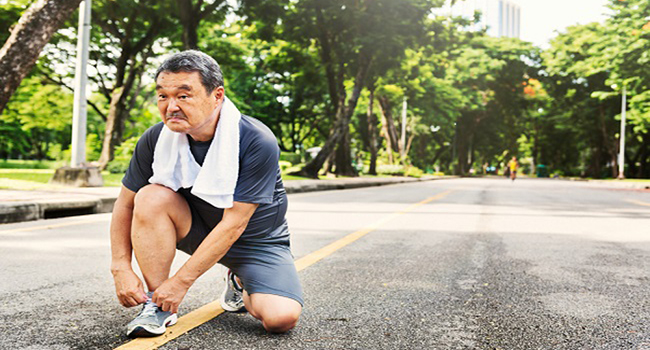
A recent clinical trial has explored the possibility of using a structured exercise plan as an additional therapy for treating depression in elderly people.
As we age, our physical and mental health may decline, making us more susceptible to depression and other mental health disorders.
Depression is a common and disabling disorder that affects more than 120 million people worldwide and a minimum of 1 in every 5 people over the course of their lifetime.
Depression is routinely treated with antidepressant drugs and psychological therapy; however, there has been a growing interest in exploring alternative non-therapeutic methods of treatment.
A recent clinical study published in the Annals of Family Medicine has shown that physical exercise may be an effective treatment for older adults with mild to moderate depression.
The clinical trial, conducted by a group of clinical researchers in Spain, sought to investigate the effectiveness of physical exercise in improving the symptoms of depression in older adults. The clinical study included 313 participants aged 65 years and older, who had been diagnosed with mild to moderate depression. The participants were divided into two groups
- Exercise group
- Control group
The patients in the exercise group completed two 60-minute exercise sessions per week for 6 months. The program consisted of a combination of aerobic exercise, strength training, and flexibility exercises. The control group, on the other hand, did not participate in any structured exercise program but received standard care for depression, including medication and counseling.
The results of the clinical study demonstrated that exercise helped reduce the symptoms of depression in these patients. The participants also reported improved physical fitness and quality of life.
These findings suggest that physical exercise can be an effective treatment for older adults with mild to moderate depression.
So, how does physical exercise help with depression? There are several mechanisms at play. Exercise releases endorphins, which are natural chemicals in the body that help to reduce pain and improve mood. Exercise also promotes the growth of new brain cells and improves the functioning of the brain's prefrontal cortex, which is responsible for regulating emotions and decision-making. Additionally, exercise can help to reduce inflammation in the body, which has been linked to depression.
However, it is pertinent to note that exercise alone cannot be viewed as an adequate therapy for depression rather; it can be used as an additional treatment in patients already receiving antidepressant drugs and counseling.
Exercise is a low-cost and low-risk intervention that can be easily incorporated into the daily routine of older adults.
In conclusion, this clinical research has provided promising results and strong evidence that physical exercise can be an effective treatment in patients with depression. It is a safe and inexpensive intervention that can significantly improve the quality of life of these patients.
It is important to understand that physical health and mental health are co-related. With advancing age, a more holistic approach should be applied to treating medical conditions.
__________
National Library of Medicine
Depression Resources
About Major Depressive Disorder
Managing Depression in Type 2 Diabetes with Melissa officinalis Extract
Zuranolone For Anxiety and Insomnia in Postpartum Depression
Improving Treatment for Bipolarl Depression
Creative Interventions to Alleviate Anxiety, Depression, during Protective Isolation
Boosting Physical Activity for Depression: A Hopeful Approach for In-Patient Treatment
Nasal Spray Effects on Treatment-Resistant Depression
Personalizing Treatment for Clinical Depression with Brain Stimulation
Probiotics may Improve Brain Function in Depression
Clinical Trial examines Predictors of Relapse in Psychotic Depression
Rapid Improvement of Postpartum Depression Symptoms with Brexanolone
Is Psilocybin Safe and Effective for Treatment-Resistant Depression?
Clinical Study Shows Mediterranean Diet Benefiicial for Depression
Stratified Care vs. Stepped Care: Which Approach is More Effective for Treating Depression?
Aural Rehabilitation is Effective in Treating Depression in Older Adults
Art Therapy: A Promising Intervention for COPD Patients with Depression
Can Cognitive Behavioral Therapy for Insomnia help Alleviate Depression?
Clinical Trial Proves Exercise is Effective in Treating Depression in the Elderly
Clinical Trial shows Balanced Diet can Reduce Depression
Depression Resources
About Major Depressive Disorder
Managing Depression in Type 2 Diabetes with Melissa officinalis Extract
Zuranolone For Anxiety and Insomnia in Postpartum Depression
Improving Treatment for Bipolarl Depression
Creative Interventions to Alleviate Anxiety, Depression, during Protective Isolation
Boosting Physical Activity for Depression: A Hopeful Approach for In-Patient Treatment
Nasal Spray Effects on Treatment-Resistant Depression
Personalizing Treatment for Clinical Depression with Brain Stimulation
Probiotics may Improve Brain Function in Depression
Clinical Trial examines Predictors of Relapse in Psychotic Depression
Rapid Improvement of Postpartum Depression Symptoms with Brexanolone
Is Psilocybin Safe and Effective for Treatment-Resistant Depression?
Clinical Study Shows Mediterranean Diet Benefiicial for Depression
Stratified Care vs. Stepped Care: Which Approach is More Effective for Treating Depression?
Aural Rehabilitation is Effective in Treating Depression in Older Adults
Art Therapy: A Promising Intervention for COPD Patients with Depression
Can Cognitive Behavioral Therapy for Insomnia help Alleviate Depression?
Clinical Trial Proves Exercise is Effective in Treating Depression in the Elderly
Clinical Trial shows Balanced Diet can Reduce Depression
